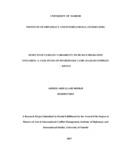| dc.description.abstract | Climate Variability is the short to medium term shift in weather patterns in a specific
region or globally. Unlike global warming, which refers increase of surface temperature
of the earth’s surface, climate variability refers to changes in regions, including
precipitation, temperatures and cloud cover among others. Experts in the field of climate
studies consider variability to be caused by human activities that have resulted in
increased concentration of greenhouse gases in the atmosphere including carbon dioxide,
water vapor, methane, Ozone, and nitrous oxide Climate variability is directly or
indirectly attributed to human activity which changes what makes up the global
atmosphere and is observed over different periods of time. The main aim of the study was
to examine the impacts of climate variability on human migration and further assess the
situation in the Dadaab refugee complex. The specific objectives were to find out the
relationship between climate variability and human migration, to assess the impact of
climate variability on IFO refugee camp, and to find out how refugees in the Daadab
complex respond/adapt to climate variability in the IFO refugee camp, in Dadaab, Kenya.
This study employed descriptive research design and it sought to describe the extent to
which climate variability and related factors lead to migration and related challenges. The
use of descriptive study enabled the researcher to find out facts without manipulating
data, inquire and search opinions, describe, analyze and interpret the influence and
relationship between the variables involved in the study. A survey methodology was used
in this study where individual respondents will be sampled from each of the target
respondents’ category in reference to the size of the target samples. Data was collected
personally by the researcher and responses were done directly into English from
Kiswahili during the interviews. After collection data was coded showing the study
locations, the different types of interviews and sex of the respondents. The study found
that Climate change is undermining the livelihoods and security of many people,
exacerbating income differentials and deepening inequalities. Over the last two decades
the number of recorded natural disasters has doubled from some 200 to over 400 per year.
The study further found that people may become displaced either within their own
countries or across international borders due to change in climate. While the latter type of
movement is less likely, at least in the initial phases of displacement, regard must also be
had to the situation of migrants who find themselves outside their country of nationality
as disaster strikes there, and are thus unable and/or unwilling to return home. The study
established in the larger context that climate change can be seen as an impact multiplier
and accelerator. In other words, in addition to its own negative impacts, climate change
may exacerbate the risk of conflict which can, in turn, cause further displacement. The
study established that while moving or fleeing to a safer location may provide temporary
relief from the negative impacts of climate change, prolonged displacement is not a longterm
solution. Protracted displacement often exacerbates existing vulnerabilities, creates
dependency, and leads to social tensions and other serious protection, humanitarian and
human rights challenges. The study concluded that existing research strongly suggests
that environmentally influenced migration is closely linked with adaptive capacity. As
such, the nature and scale of future climate migration will depend considerably on the
extent to which the global community engages in proactive capacity-building in
vulnerable populations and regions. The analogs suggest a variety of possible migration
outcomes in the absence of greenhouse gas mitigation and capacity-building efforts. The
study recommended that Better access to local meteorological data and downscaled
weather forecasts is needed to assist adaptation actions such as altering agricultural
planting practices in light of seasonal weather forecasts, determining fire-danger rating
indices and monitoring water flows to support decisions related to hydropower
management. Better access to this information would also assist in monitoring long-term
shifts in climatic patterns. The study also recommended that Direct and continual
engagement of policy-makers in pilot projects allows for hands-on learning about
effective actions and the development of strong working relationships. Policy-makers are
then better able to draw upon these lessons and relationships as opportunities arise,
facilitating the process of mainstreaming adaptation into policy- and decision-making. | en_US |



